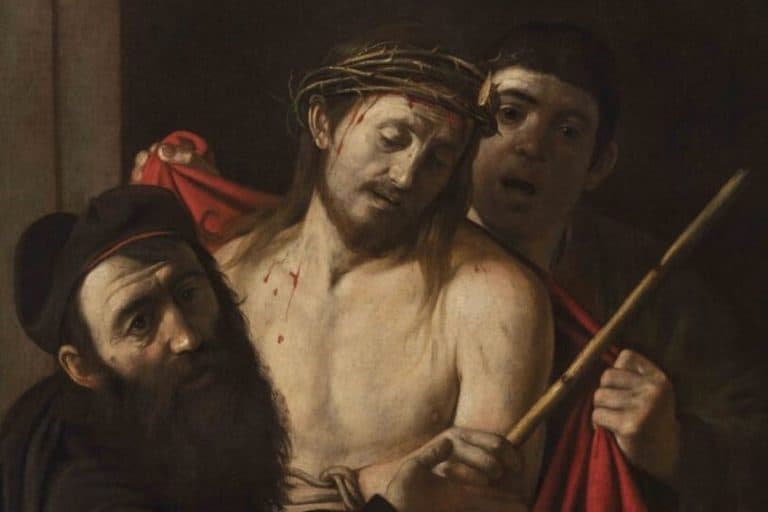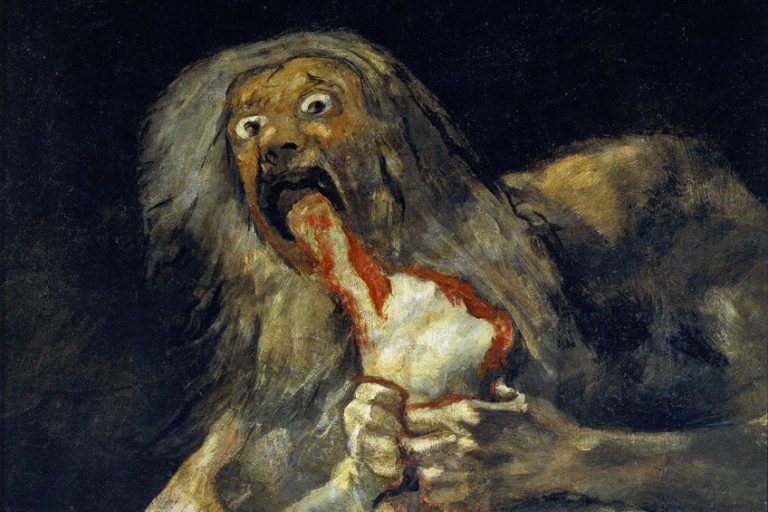Famous Paintings About War and Battles – Best War Artwork
Throughout human history, there have been conflicts and wars, and along with every war, there have been artists who have sought to capture these historic moments by producing war paintings. Sometimes these war artworks were created out of a sense of patriotism, on other occasions, famous battle paintings were commissioned for use as political propaganda or for commemorative purposes. To find out more about these conflicts, let us explore a few of the most famous paintings about war and battles.
Table of Contents
- 1 Our Top 10 List of Famous Paintings About War and Battles
- 1.1 The Battle of San Romano (1432) by Paolo Uccello
- 1.2 The Battle of Alexander at Issus (1529) by Albrecht Altdorfer
- 1.3 The Surrender of Breda (1635) by Diego Velázquez
- 1.4 The Death of General Wolfe (1770) by Benjamin West
- 1.5 The Death of Major Peirson (1783) by John Singleton Copley
- 1.6 Napoleon Crossing the Alps (1805) by Jacques-Louis David
- 1.7 The Revolt of Cairo (1810) by Anne-Louis Girodet de Roussy-Trioson
- 1.8 Battle of Cesme at Night (1848) by Ivan Aivazovsky
- 1.9 War (Krieg) (1923) by Käthe Kollwitz
- 1.10 The War (1932) by Otto Dix
- 2 Frequently Asked Questions
Our Top 10 List of Famous Paintings About War and Battles
Despite their rather gloomy subject matter, war paintings offer the artist the opportunity to create art that is relevant to their era, full of movement and emotion, deep in symbolism and allegory, and that necessitates technical skill. It was also a subject that was popular among the upper classes and therefore ensured them a market. There were also dedicated war artists that were commissioned by the government to document the experiences of war first-hand. However, as war has been such a continuous presence throughout human history, many artists have chosen to create war artworks to express their feelings about the consequences of war and the effect it had on their lives as well as those around them. Here is our list of the most renowned battle scene paintings.

The Battle of San Romano (1432) by Paolo Uccello
| Artist | Paolo Uccello (1397 – 1475) |
| Date Completed | 1432 |
| Medium | Tempera on wood |
| Dimensions (cm) | 182 x 323 |
| Location | Uffizi Gallery, Florence, Italy |
This panel is part of a series of three works commemorating the Florentine forces’ victory over the Sienese army and the coalition led by the Duke of Milan in 1432 at the Battle of San Romano. Da Tolentino, the commander of the Florentine army, is portrayed unseating Della Carda, the commander of the opposing forces, with his lance while the fight rages all around him.
The positioning of the crossbows and lances, with the Florentine troops slightly tilted forward and the enemies somewhat set back, symbolizes the eventual outcome of the conflict.
The Uffizi panel is the focal point of a narrative series that starts with Da Tolentino leading the Florentine troops in the artwork now on display at London’s National Gallery and concludes with the Attack of Da Cotignola, an ally of the Florentine army, depicted on the artwork now on display at the Louvre Museum. Only a few years after the actual event, Lionardo Bartolini Salimbeni, a prominent figure in 15th-century Florentine political life, commissioned the cycle for his residence in Florence.
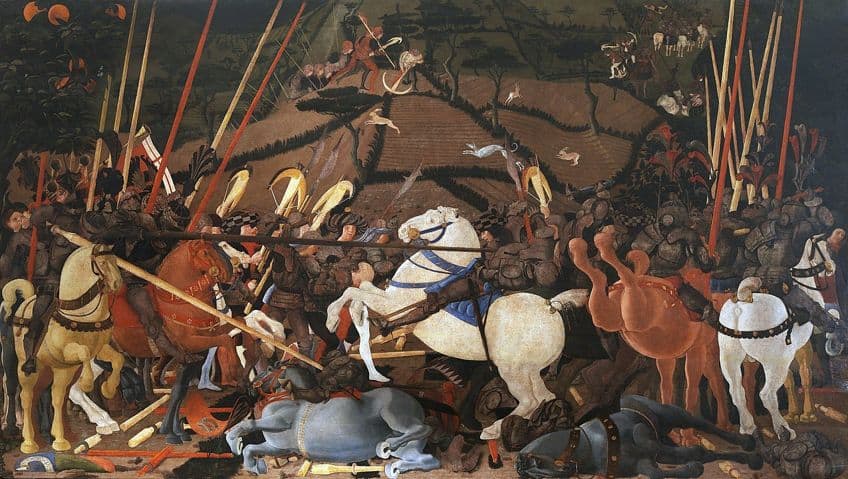
The Battle of Alexander at Issus (1529) by Albrecht Altdorfer
| Artist | Albrecht Altdorfer (1480 – 1538) |
| Date Completed | 1529 |
| Medium | Oil on panel |
| Dimensions (cm) | 158 x 120 |
| Location | Alte Pinakothek, Munich, Germany |
This artwork was produced during the Renaissance, a period in art and literature when classical themes and stories were prominent. It reflects this fascination with classical history, as well as the Renaissance’s burgeoning interest in individuality and valor. It portrays a moment from Alexander the Great’s epic confrontation with the Persian monarch Darius III in 333 BCE. It portrays Alexander riding his horse toward Darius, with a violent battle scene occurring in the distance.
Soldiers are portrayed in amazing detail in this battle scene painting, sporting bright and elaborate armor and holding various weapons.
The scenery is also represented in great detail, with steep cliffs and trees contributing to the scene’s feeling of tension and energy. This war artwork stands out for its unique use of perspective. Altdorfer used diagonal lines to create a feeling of movement, as well as to create a sense of depth by making the individuals and elements in the foreground bigger than those in the distance. Bright, contrasting colors are also used in the artwork to produce an energetic and vivid atmosphere.
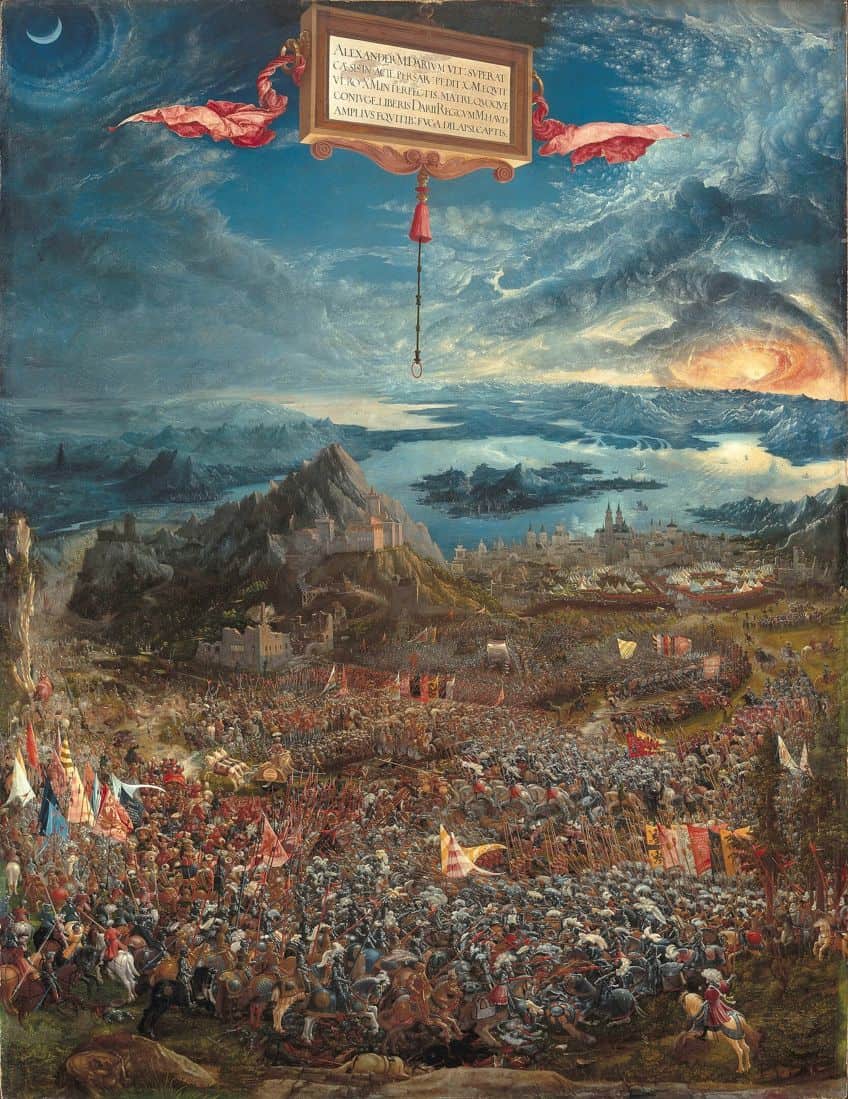
The Surrender of Breda (1635) by Diego Velázquez
| Artist | Diego Velázquez (1599 – 1660) |
| Date Completed | 1635 |
| Medium | Oil on canvas |
| Dimensions (cm) | 307 x 367 |
| Location | Museo del Prado, Madrid, Spain |
This artwork portrays the ceremonial handing over of keys that took place three days after the Dutch army’s formal surrender at Breda. As a result, the war artwork’s emphasis is on reconciliation as opposed to conflict. The key being presented to Spinola by Dutch commander Justin of Nassau and his gesture of placing his hand on his opponent’s shoulder are the focal points of the artwork. As a result, it has two meanings: first, it signifies a huge nationalist win for Spain; second, it reflects Spinola’s noble and gracious triumph.
Above all, it serves as a memorial to Velazquez’s friend Ambrogio Spinola.
The artist manages to emphasize both Spain’s peaceful intent and its military strength by highlighting Spinola’s respect for Nassau and the Dutch troops. It’s also possible that the artwork’s humanitarian tone was intended as a work of Catholic Counter-Reformation propaganda art to counteract Protestant allegations of the Spanish Inquisition’s brutality. The way Velazquez uses color in the artwork is also notable, very likely a result of his studies of Renaissance art during his trip to Italy.
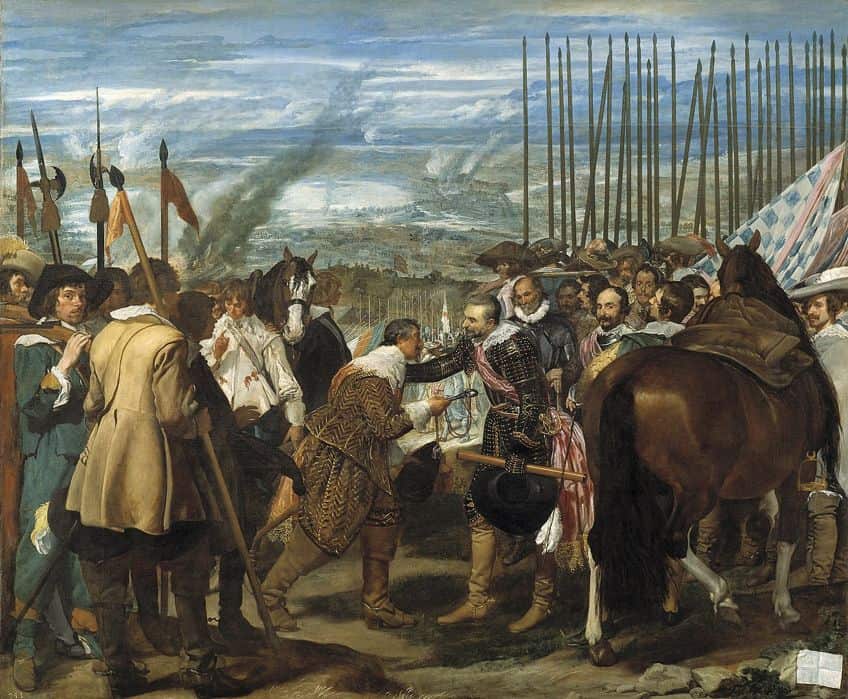
The Death of General Wolfe (1770) by Benjamin West
| Artist | Benjamin West (1738 – 1820) |
| Date Completed | 1770 |
| Medium | Oil on canvas |
| Dimensions (cm) | 151 x 213 |
| Location | National Gallery of Canada, Ottawa, Canada |
The death of James Wolfe, the British General, at the 1759 Battle of Quebec is shown in this famous war artwork picture by Benjamin West. The top of the flag and the positioning of the men form a triangular composition in which West presents General Wolfe as a Christ-like figure. The painting’s representation of the Native American warrior – crouching with his chin on his hand, gazing at General Wolfe – has been interpreted in ways.
Touching your face with your hand is seen as a sign of profound contemplation and intellect in art. Others see it as an idealization of the concept of the “noble savage”.
At the time, the clothes Benjamin West portrayed in this image were extremely divisive. While the incident was very recent (just 11 years before the painting was produced), its theme made it a suitable representation of the historical painting genre, for which contemporary clothing was inappropriate. As he was working on the war artwork, many influential people told him to portray the characters in classical garb, and when it was finished, George III refused to buy it because the clothing detracted from the event’s sense of dignity.
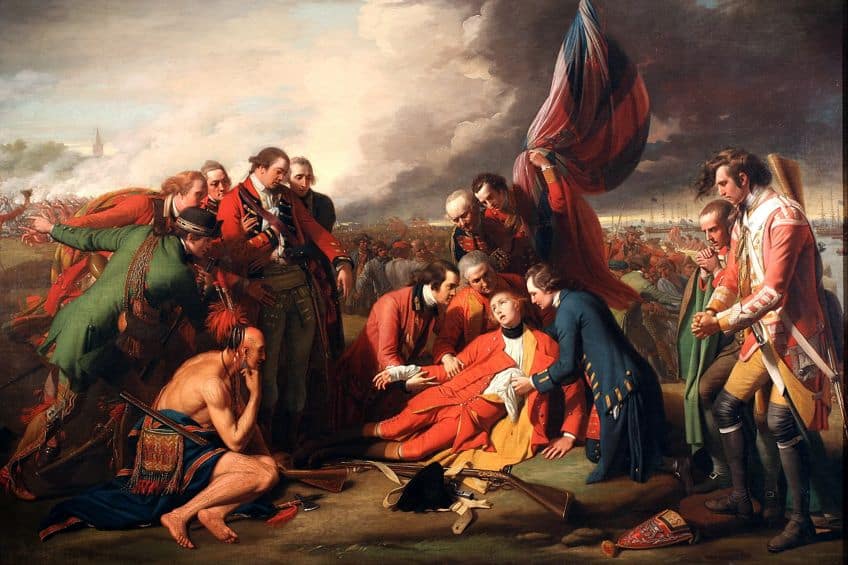
The Death of Major Peirson (1783) by John Singleton Copley
| Artist | John Singleton Copley (1738 – 1815) |
| Date Completed | 1783 |
| Medium | Oil on canvas |
| Dimensions (cm) | 147 x 366 |
| Location | Tate Britain, London, United Kingdom |
Major Francis Peirson, a British officer slain during the Battle of Jersey in 1781, is depicted in the war artwork. It portrays Peirson in the center of the scene, laying on the ground with his arm outstretched while he is surrounded by British soldiers. The people are represented in dramatic stances, with some lamenting their commander’s death and others fighting the French soldiers in the backdrop.
The action is set against the detailed backdrop of St. Helier, the capital of Jersey. It is noteworthy for portraying bravery and sacrifice.
Peirson is portrayed as a hero who sacrificed his life for his nation and his comrades. The artwork also portrays the British patriotism and nationalism of the period, as well as the spirit of honor and duty that typified the British military. It was painted in the late 18th century, during a period when historical painting was fashionable in America and Europe. It displays this fascination with historical events and figures, as well as the impact of literature and classical art on European painting.
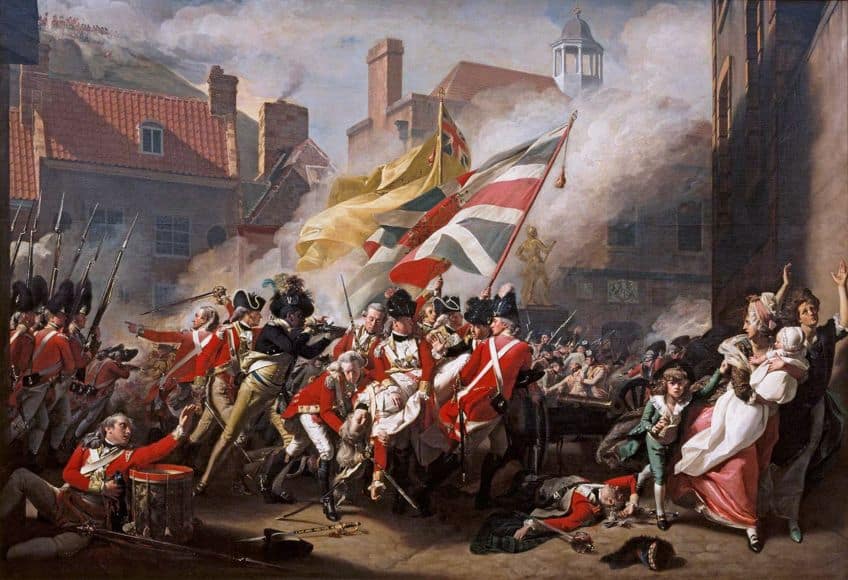
Napoleon Crossing the Alps (1805) by Jacques-Louis David
| Artist | Jacques-Louis David (1748 – 1825) |
| Date Completed | 1805 |
| Medium | Oil on canvas |
| Dimensions (cm) | 260 x 221 |
| Location | Château de Malmaison, Rueil-Malmaison, France |
Jacques-Louis David is regarded as one of the most well-known Neoclassical painters since he produced so many portraits of significant persons in politics and the arts. David started to paint images of Napoleonic wars in 1801, and his works have become instantly identifiable since then. The paintings pay respect to Napoleon’s fabled march over the Alps, which are widely considered one of the most treacherous ranges of mountains in the world.
The commander was able to offer additional support to his forces in Italy by leading them via tight tunnels that twisted their way around snow-covered mountain summits.
Jacques-Louis David was tasked with making a few paintings to memorialize one of the most audacious and brilliant military plans in recent memory. It was commissioned by the King of Spain, and Napoleon himself was approached about how he would like to be portrayed in the picture. The painting was widely reproduced and circulated throughout France and helped to establish Napoleon’s image as a powerful and charismatic leader.
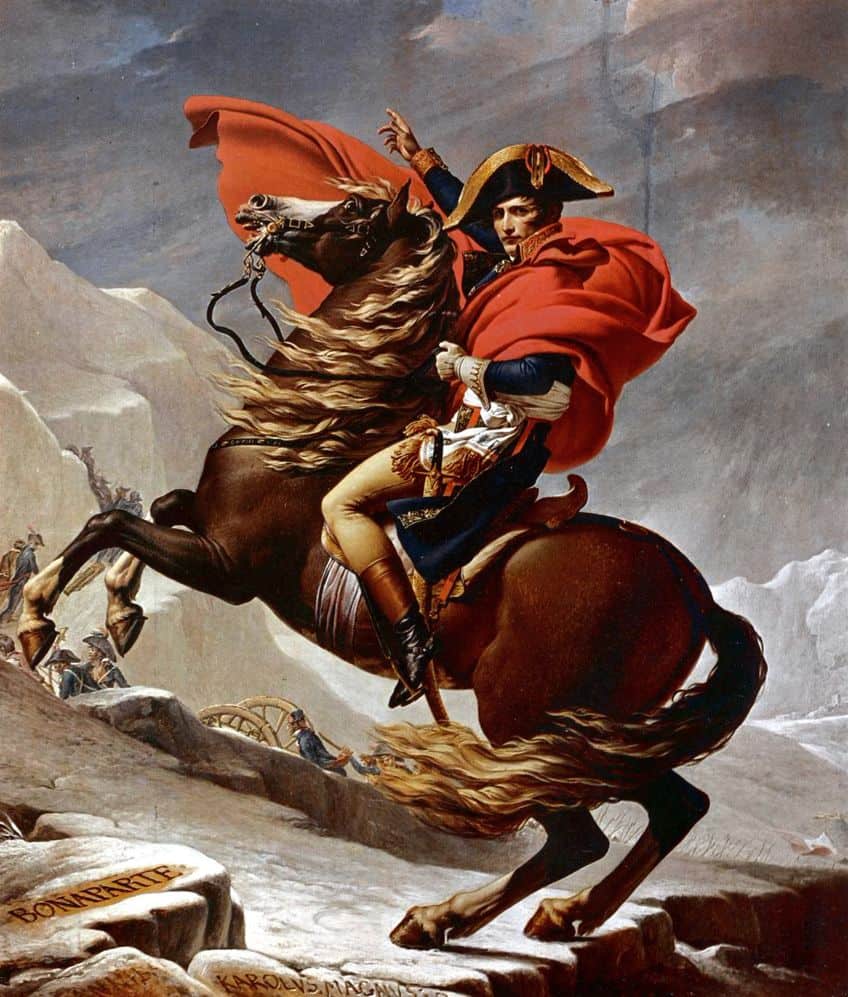
The Revolt of Cairo (1810) by Anne-Louis Girodet de Roussy-Trioson
| Artist | Anne-Louis Girodet de Roussy-Trioson (1767 – 1824) |
| Date Completed | 1810 |
| Medium | Oil on canvas |
| Dimensions (cm) | 31 x 45 |
| Location | Château de Versailles, Versailles, France |
This artwork depicts a group of Coptic Christians revolting against their Muslim masters, led by a priest raising a cross. The individuals are shown in a variety of dramatic stances, with some battling and others begging for mercy. The artwork’s background is filled with flames and smoke, implying that the revolution has turned violent. This war artwork was produced in an era when Europe was intrigued by the exoticism of North Africa and the Middle East.
The artwork was also created during the French conquest of Egypt, and it is possible that Girodet’s experiences there inspired it.
While the artwork is aesthetically appealing, it has also proven to be divisive. Some have expressed concern that the artwork perpetuates preconceptions of Muslims as tyrants and Christians as oppressed. Others have commended the artwork for its striking imagery and examination of conflicts between Egypt’s various cultural and religious groups.
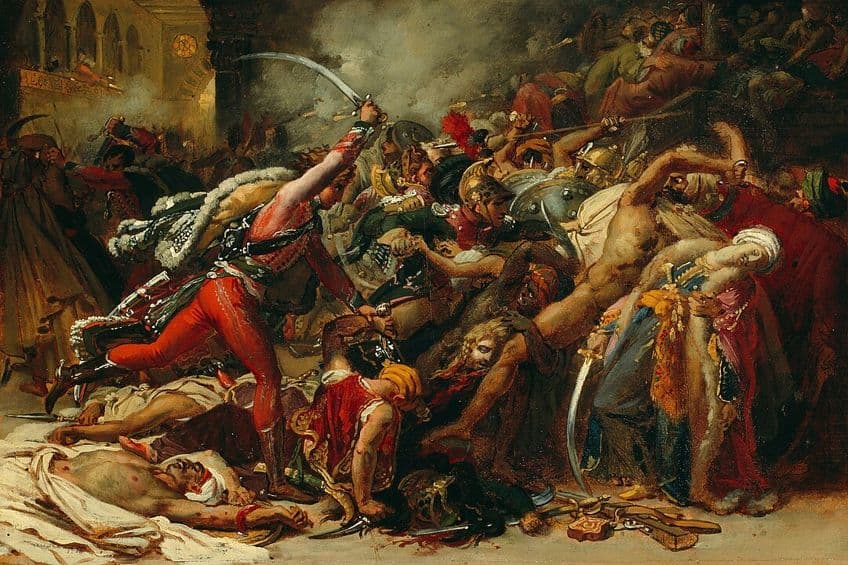
Battle of Cesme at Night (1848) by Ivan Aivazovsky
| Artist | Ivan Aivazovsky (1817 – 1900) |
| Date Completed | 1848 |
| Medium | Oil on canvas |
| Dimensions (cm) | 193 x 183 |
| Location | Aivazovsky National Art Gallery, Feodosiya, Ukraine |
The Battle of Cesme occurred in July 1770, during the Russo-Turkish War. The fight was fought between the Russian fleet, led by Admiral Alexey Orlov, and the Ottoman navy, which was stationed in the Bay of Cesme on Turkey’s western coast. The Russians won the engagement decisively, destroying a large portion of the Ottoman fleet.
Aivazovsky depicts the spectacular combat scene in this war artwork, with the Russian ships lit by the fires of burning Ottoman boats.
The artwork depicts the battle’s devastation and ferocity, with ships engulfed in flames and men fighting for their lives. The use of light and color by Aivazovsky gives a feeling of urgency and intensity, and the painting conveys the magnitude and force of the naval battle. It exemplifies Aivazovsky’s abilities as a seascape and maritime scene artist, as well as his ability to portray the drama of historical events.
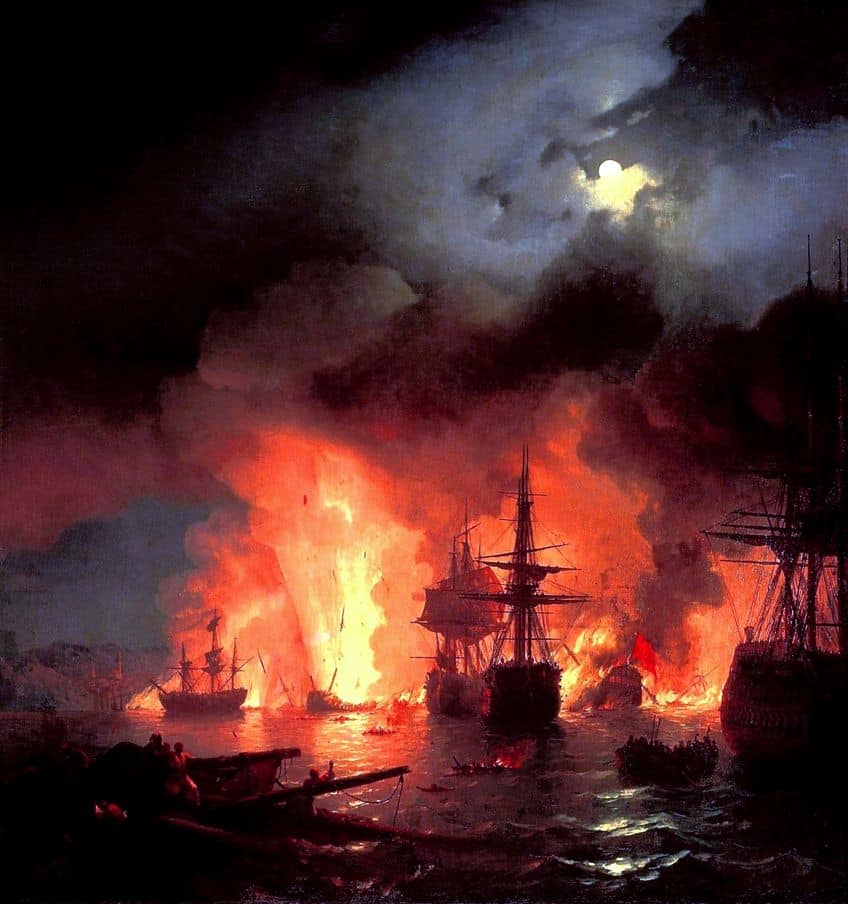
War (Krieg) (1923) by Käthe Kollwitz
| Artist | Käthe Kollwitz (1867 – 1945) |
| Date Completed | 1923 |
| Medium | Woodcut print |
| Dimensions (cm) | 47 x 65 |
| Location | Museum of Modern Art, New York City, United States |
Käthe Kollwitz started working on Krieg (War) in 1919, as a response to the horrors she experienced during the “unspeakably awful years” of World War I and its wake. The seven woodcuts depict the anguish of people left behind, including widows, mothers, and children. Kollwitz had been struggling to find the right way to express herself until she viewed an exhibition of the woodcuts of Ernst Barlach in 1920. Kollwitz radically simplified the compositions by revising each print through as many as nine preliminary sketches and stages.
The large-format, austere black-and-white woodcuts depict women who have been left to confront their grief and concerns alone, with their lovers, or with each other.
The warriors are only depicted in one print. In it, Kollwitz’s younger son, Peter, takes Death’s place, leading the army in an exuberant parade to battle. Just two months later, he died in combat. Kollwitz hoped that these pieces would be widely seen. She produced globally understandable critiques of the real sacrifices expected in exchange for abstract ideas of honor and grandeur by removing allusions to a specific period or place.
The War (1932) by Otto Dix
| Artist | Otto Dix (1891 – 1969) |
| Date Completed | 1932 |
| Medium | Oil on wood |
| Dimensions (cm) | 204 x 60 |
| Location | Galerie Neue Meister, Dresden, Germany |
Before the First World War, Dix attended Dresden University of Art. Otto Dix served in the Imperial German Army in 1915 and fought as a machine gunner. He went back to school for fine arts after his service. Dix’s traumatic memories of his time in the trenches served as the inspiration for his anti-war artwork produced after 1920. In 1927, he was appointed as a professor at the Dresden Academy. In response to the general public’s opinion of the First World War as a heroic event, he began work on the triptych shortly after the 10th anniversary of its end.
The Nazi Party classified several of Dix’s paintings as degenerate art, but the triptych was concealed by Dix and managed to survive. The triptych is divided into three major panels, with the left panel depicting a procession of German soldiers walking away from the observer through the fog of war toward the conflict in the center. The middle panel depicts a ravaged urban environment strewn with war paraphernalia and human remains, while the right panel depicts a few people fleeing the conflict.
That completes our list of famous paintings about war and battles. As we have seen, war paintings have been produced for almost as long as humans have been at war. Battle paintings help to memorialize these moments for future generations of historians to examine for clues as to what occurred, or at least to gain insight into the way these wars were perceived by the population and the artists themselves.
Take a look at our war paintings webstory here!
Frequently Asked Questions
What Is the Significance of Battle Scene Paintings?
They serve as visual documentation of historical events and aid in the preservation of memories of major military wars. War paintings record crucial periods in military history and can act as a constant reminder of the struggles and bravery of troops, as well as the consequences of war on civilians and civilization as a whole. Many battle scene paintings are made by well-known artists, and their work might reflect the aesthetic and artistic tendencies of the moment.
Why Were Famous Battle Paintings Produced?
War paintings can be used as political or propaganda weapons. War paintings are frequently commissioned by administrations or military commanders to promote a certain cause or purpose. They might be used to influence public sentiment and bolster support for a war effort, or they may be employed to advocate a certain sense of national identity or nationalism. War paintings are crucial for representing and interpreting military history. They provide a unique viewpoint on the effects of conflict on people and civilizations. They serve as reminders of the violent past and troublesome history of humankind.
Isabella studied at the University of Cape Town in South Africa and graduated with a Bachelor of Arts majoring in English Literature & Language and Psychology. Throughout her undergraduate years, she took Art History as an additional subject and absolutely loved it. Building on from her art history knowledge that began in high school, art has always been a particular area of fascination for her. From learning about artworks previously unknown to her, or sharpening her existing understanding of specific works, the ability to continue learning within this interesting sphere excites her greatly.
Her focal points of interest in art history encompass profiling specific artists and art movements, as it is these areas where she is able to really dig deep into the rich narrative of the art world. Additionally, she particularly enjoys exploring the different artistic styles of the 20th century, as well as the important impact that female artists have had on the development of art history.
Learn more about Isabella Meyer and the Art in Context Team.
Cite this Article
Isabella, Meyer, “Famous Paintings About War and Battles – Best War Artwork.” Art in Context. April 28, 2023. URL: https://artincontext.org/famous-paintings-about-war-and-battles/
Meyer, I. (2023, 28 April). Famous Paintings About War and Battles – Best War Artwork. Art in Context. https://artincontext.org/famous-paintings-about-war-and-battles/
Meyer, Isabella. “Famous Paintings About War and Battles – Best War Artwork.” Art in Context, April 28, 2023. https://artincontext.org/famous-paintings-about-war-and-battles/.







